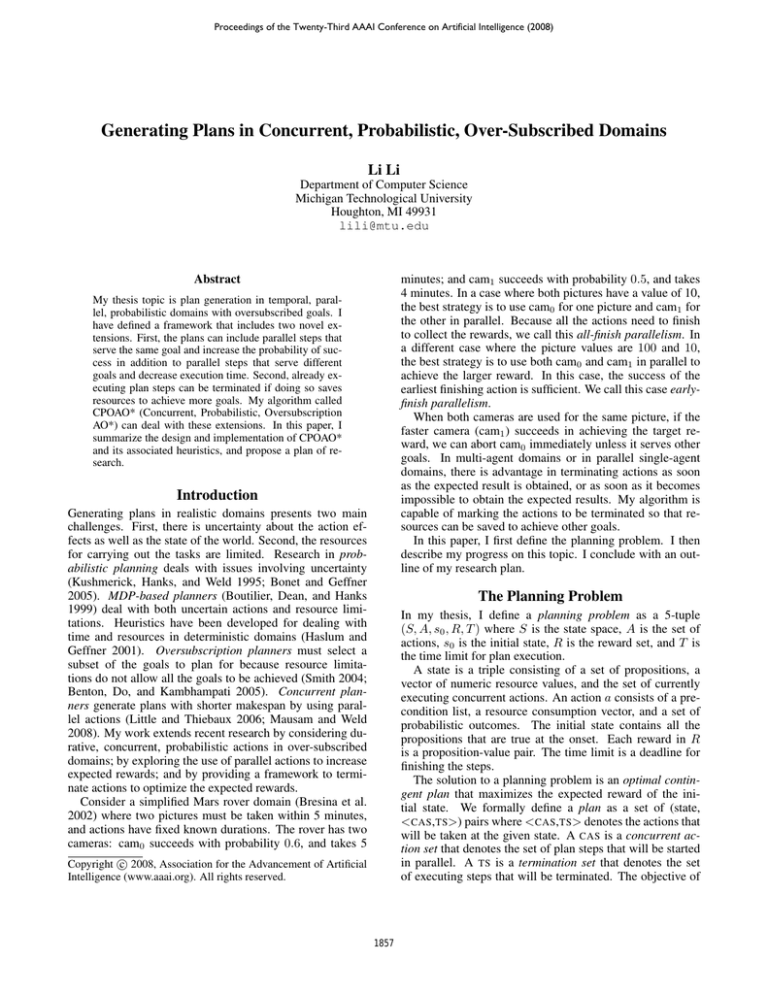
Proceedings of the Twenty-Third AAAI Conference on Artificial Intelligence (2008)
Generating Plans in Concurrent, Probabilistic, Over-Subscribed Domains
Li Li
Department of Computer Science
Michigan Technological University
Houghton, MI 49931
lili@mtu.edu
minutes; and cam1 succeeds with probability 0.5, and takes
4 minutes. In a case where both pictures have a value of 10,
the best strategy is to use cam0 for one picture and cam1 for
the other in parallel. Because all the actions need to finish
to collect the rewards, we call this all-finish parallelism. In
a different case where the picture values are 100 and 10,
the best strategy is to use both cam0 and cam1 in parallel to
achieve the larger reward. In this case, the success of the
earliest finishing action is sufficient. We call this case earlyfinish parallelism.
When both cameras are used for the same picture, if the
faster camera (cam1 ) succeeds in achieving the target reward, we can abort cam0 immediately unless it serves other
goals. In multi-agent domains or in parallel single-agent
domains, there is advantage in terminating actions as soon
as the expected result is obtained, or as soon as it becomes
impossible to obtain the expected results. My algorithm is
capable of marking the actions to be terminated so that resources can be saved to achieve other goals.
In this paper, I first define the planning problem. I then
describe my progress on this topic. I conclude with an outline of my research plan.
Abstract
My thesis topic is plan generation in temporal, parallel, probabilistic domains with oversubscribed goals. I
have defined a framework that includes two novel extensions. First, the plans can include parallel steps that
serve the same goal and increase the probability of success in addition to parallel steps that serve different
goals and decrease execution time. Second, already executing plan steps can be terminated if doing so saves
resources to achieve more goals. My algorithm called
CPOAO* (Concurrent, Probabilistic, Oversubscription
AO*) can deal with these extensions. In this paper, I
summarize the design and implementation of CPOAO*
and its associated heuristics, and propose a plan of research.
Introduction
Generating plans in realistic domains presents two main
challenges. First, there is uncertainty about the action effects as well as the state of the world. Second, the resources
for carrying out the tasks are limited. Research in probabilistic planning deals with issues involving uncertainty
(Kushmerick, Hanks, and Weld 1995; Bonet and Geffner
2005). MDP-based planners (Boutilier, Dean, and Hanks
1999) deal with both uncertain actions and resource limitations. Heuristics have been developed for dealing with
time and resources in deterministic domains (Haslum and
Geffner 2001). Oversubscription planners must select a
subset of the goals to plan for because resource limitations do not allow all the goals to be achieved (Smith 2004;
Benton, Do, and Kambhampati 2005). Concurrent planners generate plans with shorter makespan by using parallel actions (Little and Thiebaux 2006; Mausam and Weld
2008). My work extends recent research by considering durative, concurrent, probabilistic actions in over-subscribed
domains; by exploring the use of parallel actions to increase
expected rewards; and by providing a framework to terminate actions to optimize the expected rewards.
Consider a simplified Mars rover domain (Bresina et al.
2002) where two pictures must be taken within 5 minutes,
and actions have fixed known durations. The rover has two
cameras: cam0 succeeds with probability 0.6, and takes 5
The Planning Problem
In my thesis, I define a planning problem as a 5-tuple
(S, A, s0 , R, T ) where S is the state space, A is the set of
actions, s0 is the initial state, R is the reward set, and T is
the time limit for plan execution.
A state is a triple consisting of a set of propositions, a
vector of numeric resource values, and the set of currently
executing concurrent actions. An action a consists of a precondition list, a resource consumption vector, and a set of
probabilistic outcomes. The initial state contains all the
propositions that are true at the onset. Each reward in R
is a proposition-value pair. The time limit is a deadline for
finishing the steps.
The solution to a planning problem is an optimal contingent plan that maximizes the expected reward of the initial state. We formally define a plan as a set of (state,
<CAS,TS>) pairs where <CAS,TS> denotes the actions that
will be taken at the given state. A CAS is a concurrent action set that denotes the set of plan steps that will be started
in parallel. A TS is a termination set that denotes the set
of executing steps that will be terminated. The objective of
c 2008, Association for the Advancement of Artificial
Copyright Intelligence (www.aaai.org). All rights reserved.
1857
serve the same goal might be terminated. Both admissible
and nonadmissible heuristics can be explored for finding expected rewards and action termination conditions.
Other approaches: I plan to integrate the research
in concurrent MDP (co-MDP) based frameworks into my
framework that includes early finish parallelism and action
termination. I believe the transfer of ideas can be both ways:
my reachability-based heuristics can be used in MDP frameworks and dynamic programming techniques for MDPs can
be used in my framework.
Domain modeling: In light of my research findings in
the previous two areas, I plan to extend the current domain
model to include continuous resources, renewable resources,
and stochastic resource consumption. This will bring my
framework closer to real world systems.
my research is to develop an algorithm and heuristics that
can solve such problems. In the next section, I outline my
progress.
Research Activities
I have developed and implemented an algorithm named
CPOAO* (Concurrent, Probabilistic, Oversubscription
AO*). CPOAO* searches in a space of states considering
the possible actions that can be started and the executing actions that can be terminated in each state. Each node in the
search tree represents a state, and the root node is the initial
state. The value of a state is the sum of the expected rewards
in this state. The value of a terminal node is computed by
adding the values of the rewarded propositions.
My research to date has been concerned with increasing
the efficiency of CPOAO* by considering two questions related to the search process: (1) How can the set of applicable
<CAS,TS> pairs be selected effectively? (2) How can the
search be guided? To address the first question, I use rules
to prune concurrent action sets based on a “better” relationship. For example, we should never choose a concurrent
action set that undoes the effects of the just finished actions.
For domains where time is the only resource modeled, starting an action earlier is always better than starting it later or
being idle because we can abort it at any time. To address the
second question, I designed and implemented a technique
based on reachability analysis where I construct a reverse
planning graph (rpgraph) to compute the expected rewards
of a state. For each goal, an rpgraph is created by first placing the goal proposition at the initial level. Then, alternating levels of action and proposition nodes are created. For
each proposition at the last level, an action that can achieve
this proposition is inserted into the next level. Each proposition node contains a resource list indicating the resources
required to reach the goal from this proposition node. The
resource levels are updated using the resource requirements
of the actions. The expansion of the rpgraph stops when the
level of any resource exceeds the value present in the initial
state. Each time a new intermediate node is generated, this
graph is used to compute an upper bound on the expected
rewards and thus heuristically guide the search. I have reported the preliminary results of my experiments in (Li and
Onder 2007). My recent experiments show up to one order
of magnitude improvement in the search process. In the next
section, I outline my research plan.
References
Benton, J.; Do, M. B.; and Kambhampati, S. 2005. Oversubscription planning with numeric goals. Proc. IJCAI-05.
Bonet, B., and Geffner, H. 2005. mGPT: A probabilistic planner
based on heuristic search. J. of Artificial Intelligence Research
24:933–944.
Boutilier, C.; Dean, T.; and Hanks, S. 1999. Decision theoretic
planning: Structural assumptions and computational leverage. J.
of Artificial Intelligence Research 11:1–94.
Bresina, J. L.; Dearden, R.; Meuleau, N.; Ramakrishnan, S.;
Smith, D. E.; and Washington, R. 2002. Planning under continuous time and resource uncertainty: A challenge for AI. In
Proc. UAI-02, 77–84.
Haslum, P., and Geffner, H. 2001. Heuristic planning with time
and resources. In Proc. 6th European Conference on Planning.
Kushmerick, N.; Hanks, S.; and Weld, D. 1995. An algorithm for
probabilistic planning. Artificial Intelligence 76:239–86.
Li, L., and Onder, N. 2007. Generating plans in concurrent, probabilistic, over-subscribed domains. In ICAPS-07 3rd Workshop on
Planning and Plan Execution for Real-World Systems: Principles
and Practices for Planning in Execution.
Little, I., and Thiebaux, S. 2006. Concurrent probabilistic planning in the graphplan framework. In Proc. ICAPS-06, 263–272.
Mausam, and Weld, D. S. 2008. Planning with durative actions in
stochastic domains. J. of Artificial Intelligence Research 31:33–
82.
Smith, D. E. 2004. Choosing objectives in over-subscription planning. In Proc. ICAPS-04.
Proposed Research
My future activities will be in the following areas:
Heuristics: I plan to improve the heuristics I have implemented. Possibilities include a factored representation of
the reward structure and using previously cached values to
find the expected rewards. Theories on how to detect useless actions in parallel domains can be developed. One possibility is to use causal link analysis to find the goals that
are served by each action and terminating the actions that
serve the same goal when an action finishes with success.
Similarly, achieving some goals might become impossible
when an action finishes with failure. The other actions that
1858




